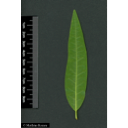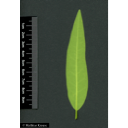Useful information about the taxon (species, subspecies, variety...)
Umbellularia californica (Hook. & Arn.) Nutt. 1842
Lauraceae
- Laurel family (APG IV)California laurel, California bay, Oregon myrtle
Taxon concept: The Plant List (2010)
Distribution: USA: California, Oregon
Umbellularia californica (Hook. & Arn.) Nutt. - Accepted: Umbellularia californica (Hook. & Arn.) Nutt. bei Zander 2008; Familie: Lauraceae (Zander 2008)Umbellularia californica (Hook. & Arn.) Nutt. - Accepted: Umbellularia californica (Hook. & Arn.) Nutt. bei The Plant List (2010); Familie: Lauraceae (APG III)Umbellularia californica (Hook. & Arn.) Nutt. - Accepted: Umbellularia californica (Hook. & Arn.) Nutt. bei The Plant List (2014), version 1.1; Familie: Lauraceae (APG III)Umbellularia californica (Hook. & Arn.) Nutt. - Accepted: Umbellularia californica (Hook. & Arn.) Nutt. bei The Plant List (2014), version 1.1; Familie: Lauraceae (APG IV)Umbellularia californica (Hook. & Arn.) Nutt. - Accepted: Umbellularia californica (Hook. & Arn.) Nutt. bei Zander 2008; Familie: Lauraceae (APG IV)
- Color of flower
- pale yellow
- Flowers
- hermaphroditic flowers
- Flower ecology
- insect-pollinated (entomophilous)
- Life form
- tree or shrub
- Leaves
- lanceolate, entire-margined, aromatic
- Foliage persistence
- evergreen
- Fruits
- drupe with a single large and thin-shelled seed
- Fruit ecology
- gravity-dispersed (barochorous), water-dispersed (hydrochorous) and animal-dispersed (zoochorous)
- Soil conditions
- on loam, sandy-loam, or clay soils
- Root type
- rather shallow-rooted (no taproot)
- Succession type
- occuring in all seral stages
- Natural occurrence (habitat)
- evergreen shrubland, serpentine chaparral, exposed ridges, steep mountain slopes, coastal bluffs, rocky outcrops, well-drained alluvial benches, valley bottoms subjected to occasional inundation, along foothill streams
- Vegetation typ and synecology (plant community)
- warm-temperate (mediterranean), xerophytic to mesophytic mixed evergreen forests and sclerophyllous forests, woodlands, and scrub (California hardwood forests and chaparral); in associations with broad-leaved trees e.g. oaks, boxelder, eucalyptus, and with coniferous trees like Douglas fir
- Constraints according radiation (light)
- sun- and shade-tolerant
- Constraints according habitat
- not windfirm
- Usage
- wood is used for furniture, cabinets, interior trim, paneling, veneer, gunstocks, and turned woodenware; also used for wood carvings and other fine making items (marketed as "myrtlewood"); used as ornamental tree
- Phytopathogenic organisms
- is affected by heart rot, a disease caused by the fungus Ganoderma applanatum
- Bark
- thin, smooth to scaly bark
- Altidudinal lower limit (sea level in m)
- 0
- Altitudinal higher limit (sea level in m)
- 1,524
Erhardt, W., Götz, E., Bödeker, N. & Seybold, S. (2008): Der große Zander. Enzyklopädie der Pflanzennamen. Band 2. Arten und Sorten. Eugen Ulmer KG, Stuttgart (Hohenheim), 18. Aufl., 2103 S.; Howard, J. L. (1992): Umbellularia californica. In: Fire Effects Information System, [Online]. U.S. Department of Agriculture, Forest Service, Rocky Mountain Research Station, Fire Sciences Laboratory (Producer). See: https://www.fs.fed.us/database/feis/plants/tree/umbcal/all.html; Plants for a Future (1996-2012): PFAF. See: https://pfaf.org/; The International Plant Names Index (2009). Published on the Internet http://www.ipni.org; Courtesy to IPNI, 2009. Exported from IPNI at date: 2009-09-22 20:17:51;
Last update:
Taxonomic update: Helmut Dalitz on: 21.12.2023Update of the description: Matthias Krause; latest by: Matthias Krause on: 11.3.2019In the list below you will find the geographic coordinates of many woody plants in the garden. In these cases the points are marked in the map. If no coordinates are listed, the coordinate of the point in the map marks the middle coordinate of the section.| Sex | Standort | Accession number | Planting year | Donation | IPEN | Lat. | Long. |
|---|


